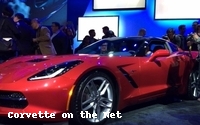Commentary
CES & the Connected Car for Commerce
- by Chuck Martin , Staff Writer, January 7, 2014
 Mobile commerce may soon be taking to the
roads.
Mobile commerce may soon be taking to the
roads.
One of the earlier big presentations here at the International CES show in Las Vegas was the networked car by Chevrolet. With two cars on stage and another in the back of a large room, GM execs demonstrated how they expect consumers will be using mobile technology inside the vehicle.
People have been talking about networked cars for some time, of course. But at CES, GM announced its partnership with AT&T so that all future Chevys would be shipped with network technology included in the car and then showed cars with the network working in them.
Conceptually, GM and AT&T see the car as another potential mobile device on the network. For a shared data plan, for example, there could be your smartphone, tablet and your car. App developers already have been customizing apps for Chevrolet.
Other recent announcements point to the car increasingly being treated as a media-consuming vehicle. Pandora noted this week that to follow its more than four million car listeners it’s launching in-car advertising in the form of 15- and 30-second spots.
This is roughly the same patterns as with mobile, with advertising following content to reach the people consuming that content.
Key for mobile commerce here is that commerce typically follows that and it can follow in a big way, based on the size and growth of mobile shopping already.
The obvious point here is that the networked car is increasingly becoming a potentially huge driver of mobile commerce, literally.
Although mobile commerce can be done in a car today, shopping or buying in it on a smartphone can be somewhat daunting, for a host of reasons.
Consumers in transit, a portion of the Mobile Shopping Life Cycle, as we’ve written about frequently here, can be increasingly be reached and influenced by more sophisticated targeting technologies.
But reaching them through the actual vehicle in which they’re driving could bring this to a whole new level.
Capabilities such as hands free, voice activation and mapping integration could be effective within a driving event, especially when routed through the vehicle itself.
OnStar has been working on interfacing with driving consumers for many years so has the inherent DNA to make this work.
“It’s going to be seamless and it’s just going to work,” Timothy Nixon, GM executive director and chief technology officer of OnStar told me after the CES presentation.
“As soon as you start the car, the Wi Fi hot spot energizes,” he says. “If you bring a smartphone or tablet into the car, you can connect that device into the hot spot and you can attach up to seven devices.”
As might be expected, the first forays tapping into networked cars are to send content and then advertising.
However, a might bigger play may be just behind that, especially once consumers become comfortable on the network via their vehicle.
“This is really about the core technology and capability,” says Nixon. “You can transform the car over time. For commerce, we’re looking at a number of different avenues on how we can maximize the use of these connections. We’re all about reducing the friction.”
Mobile commerce may soon become even more mobile.




Back to the Future is coming to life
You may be right, Gordon.